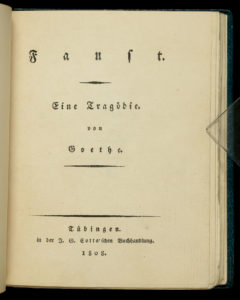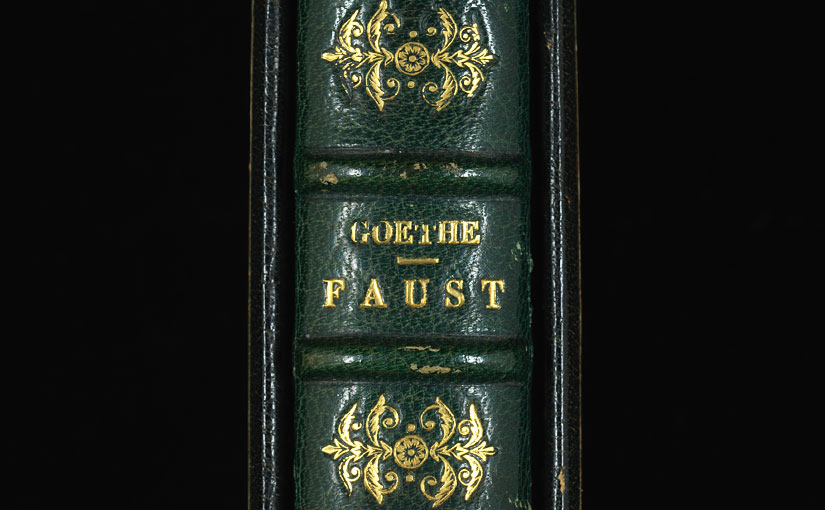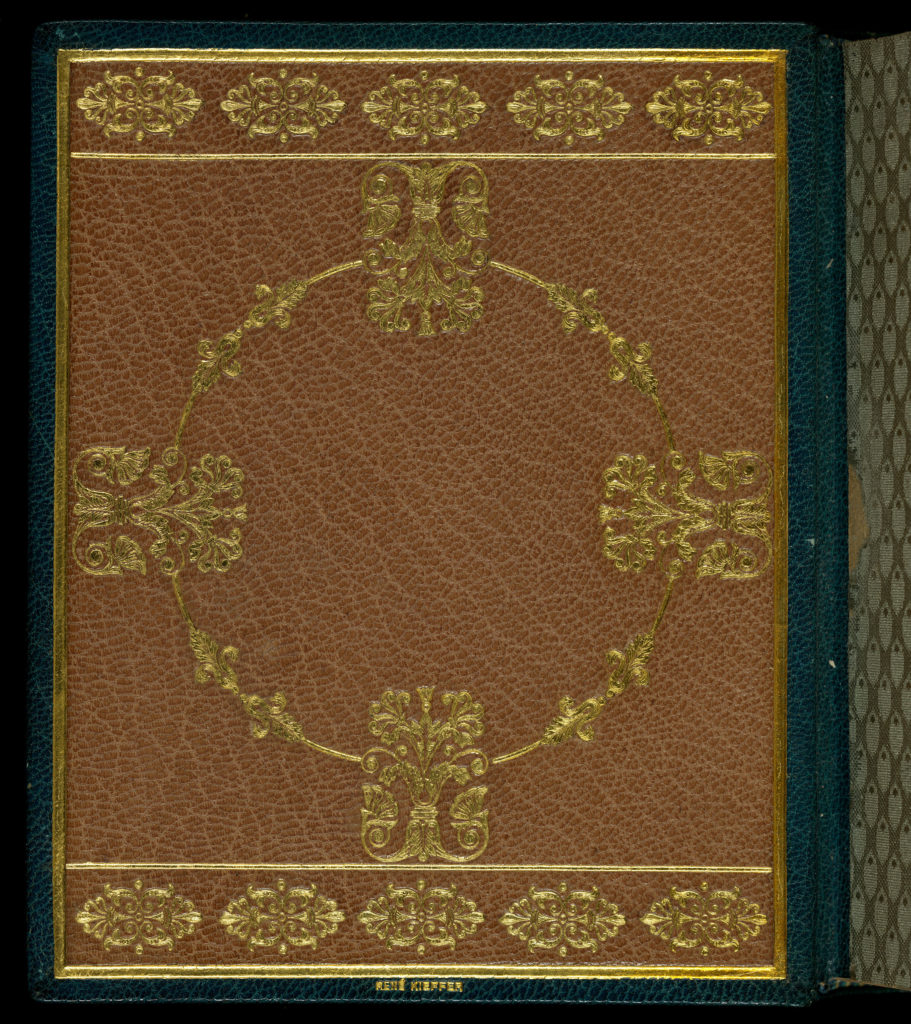 by Julie Tanaka, Curator, Rare Books and Joe Ross, Original Cataloger for Special Collections
by Julie Tanaka, Curator, Rare Books and Joe Ross, Original Cataloger for Special Collections
Enhancing the German literature holdings is the recent acquisition of Faust: Eine Tragödie, the first edition of Johann Wolfgang von Goethe’s work published in 1808 by J. G. Cotta’schen Buchhandlung in Tübingen.
Faust, the two-part epic poem written by Johann Wolfgang von Goethe (1749-1832), a masterpiece of German literature, reflects the transforming world in which Goethe lived. Begun in the waning years of the Holy Roman Empire (the final dissolution marked by the abdication of Francis II on August 6, 1806) and almost a century before the unification of Germany in 1871 into a nation-state, Goethe’s work exhibits his understanding of the world in upheaval—the revolutions in America and France and the Napoleonic Wars, the rise of Romanticism in literature and art, the Kantian Revolution in philosophy, the Industrial Revolution in science, technology, and economics.
Goethe, drawing upon Gotthold Ephraim Lessing’s call for German dramatists to establish their independence from the French and to treat the Faust tragedy as a specifically German theme began composing his version around 1773. Goethe’s work went through numerous stages. The earliest version, known as the Urfaust, was probably finished by 1775 and the next revision, known as Faust: Ein Fragment, appeared in 1790. After almost a decade, Goethe returned to Faust, adding the prologues, the second part of “Night”, and “Walpurgis Night.” This version now referred to as Part I was finished in 1806 and published two years later. Goethe continued to work on Faust sporadically in the 1820s and completed Part II in 1831 but sealed the completed manuscript—though he made a few final corrections in early 1832—to be published only after his death.
In composing Faust, Goethe drew upon the so-called Faust tradition of texts dating to the early Christian period, but this source base forms only a small part of what he used in his composition. Goethe anchors his Faust firmly in the European tradition, alluding to and parodying ancient Greek and Roman authors including Homer, Hesiod, Herodotus, Apollonius, and Ovid as well as the more contemporary figures of Dante, Shakespeare, Milton, and Calderón de la Barca.
This copy was bound by René Kieffer (1875-1964), one of the foremost Parisian binders of the early twentieth century. Kieffer was trained in classical techniques and worked as a gilder for a decade at the Chambolle-Duru bindery in Paris. After opening his own shop in 1903, he found new inspiration from the father-son binders Jean Michel (1821-90) and Henri François (1846-1925) in Paris. The influence of the latter’s use of curved stamps to work floral and leaf forms is evident in Kieffer’s work.
A fine example of Kieffer’s adoption of the Art Nouveau style, this copy of the first edition of Faust is bound in gilt-tooled green morocco over stiff paper boards. Four rectangular panels on the upper and lower boards display four central lily ornaments. Each rectangle has a floral ornament in the center with four lily corner-pieces. The covers bear a single gilt fillet border, and the spine is gilt-tooled morocco with five raised bands with panels that have a central rose with foliate ornaments on either side. “Goethe / Faust” in gilt lettering appears in the title panel at the top and the bottom panel bears 1808 below the floral ornament. Inside the book are brown morocco doublures (decorative linings, shown above) with a gilt broken circle. Lily ornaments break the line between the four large lily ornaments at top and bottom and either side. A single fillet border surrounds the five floral ornaments that form the upper and lower border. The free end-leaves are silken with diagonal beaded line grain, a full-page floral water-color on verso of free end-leaves. This fine volume is housed in a slip case also designed by Kieffer.
Works Consulted
- Brown, Jane K. “Faust.” In The Cambridge Companion to Goethe. Edited by Leslie Sharpe. Cambridge: Cambridge University Press, 2002. Pp. 84-100.
- Sharpe, Leslie. “Introduction.” In The Cambridge Companion to Goethe. Edited by Leslie Sharpe Cambridge: Cambridge University Press, 2002. Pp. 1-5.
- Sanjuan, Agathe. Les éditions René Kieffer, 1909-1950. Paris: A. Sanjuan, 2002. <http://www.chartes.psl.eu/fr/positions-these/editions-rene-kieffer-1909-1950/>.
- Arwas, Victor. Art Nouveau: The French Aesthetic. London: Andreas Papadakis Publisher, 2002.
- Roberts, Matt, Don Etherington, and Walter Henry. “Michel, Marius.” In Bookbinding and the Conservation of Books. New Castle, DE: Oak Knoll Press, 2003. <http://cool.conservation-us.org/don/dt/dt2225.html/>.


